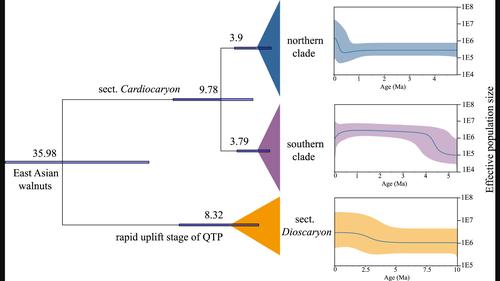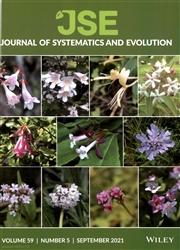核桃物种内部的人口复杂性有助于深入了解东亚地质和气候波动的异质性
IF 2.9
1区 生物学
Q1 Agricultural and Biological Sciences
引用次数: 0
摘要
东亚是全球植物多样性面积最大、最复杂的地区之一。这种复杂性可归因于东亚的地质历史和气候多样性。然而,有关这一主题的生物地理学假说和不同研究一直存在争议。人们对东亚温带落叶木本植物的种群复杂性以及地质和气候波动的异质性仍然知之甚少。我们旨在组装东亚五个核桃(Juglans)物种 360 个个体的叶绿体和核基因组,并全面分析其系统发育推断、遗传结构、种群人口学和选择压力。结果表明,东亚核桃可分为两大类,即 Juglans/Dioscaryon 科和 Cardiocaryon 科。Cardiocaryon。在 Cardiocaryon 科内样本分为北部支系和南部支系,这两个支系都受到了第四纪冰川作用的影响;但南部支系受到的影响较小。在Cardiocaryon和Sect.Cardiocaryon 和 sect.中新世晚期以来的种群扩张事件表明,新近纪气候变冷对第三纪孑遗植物在东亚的分布产生了重大影响。生物地理学分析结果表明,青藏高原的隆起可能是造成薯蓣科内部分化的原因之一。Dioscaryon.我们的研究结果突显了新近纪晚期和第四纪期间东亚南北地区气候波动的异质性,并表明青藏高原的隆升可能促进了温带落叶木本植物的分化。本文章由计算机程序翻译,如有差异,请以英文原文为准。

Demographical complexity within walnut species provides insights into the heterogeneity of geological and climatic fluctuations in East Asia
East Asia constitutes one of the largest and most complex areas of plant diversity globally. This complexity is attributable to the geological history and climatic diversity of East Asia. However, controversy persists over the biogeographical hypotheses and different studies on this topic. The demographical complexity of temperate deciduous woody plants and heterogeneity of geological and climatic fluctuations in East Asia remain poorly understood. We aimed to assemble the chloroplast and nuclear genomes of 360 individuals from five walnut (Juglans ) species in East Asia and comprehensively analyze the phylogenetic inference, genetic structure, population demographic, and selection pressure. The results showed that East Asian walnuts could be divided into two major groups, that is, section Juglans /Dioscaryon and sect. Cardiocaryon . Within sect. Cardiocaryon , the samples were categorized into the northern clade and southern clade, both of which were affected by Quaternary glaciation; however, the southern clade was affected to a lesser extent. The population expansion events observed in sect. Cardiocaryon and sect. Dioscaryon since the late Miocene indicated that Neogene climate cooling substantially affected the distribution of Tertiary relict plants in East Asia. Biogeographic analysis results showed that the uplift of the Qinghai–Tibetan Plateau (QTP) might have contributed to the divergence within sect. Dioscaryon . Our findings highlight the heterogeneity of climatic fluctuations in the northern and southern regions of East Asia during the late Neogene and Quaternary periods and suggest that the uplift of QTP could have facilitated the divergence of temperate deciduous woody plants.
求助全文
通过发布文献求助,成功后即可免费获取论文全文。
去求助
来源期刊

Journal of Systematics and Evolution
Agricultural and Biological Sciences-Ecology, Evolution, Behavior and Systematics
CiteScore
7.40
自引率
8.10%
发文量
1368
审稿时长
6-12 weeks
期刊介绍:
Journal of Systematics and Evolution (JSE, since 2008; formerly Acta Phytotaxonomica Sinica) is a plant-based international journal newly dedicated to the description and understanding of the biological diversity. It covers: description of new taxa, monographic revision, phylogenetics, molecular evolution and genome evolution, evolutionary developmental biology, evolutionary ecology, population biology, conservation biology, biogeography, paleobiology, evolutionary theories, and related subjects.
 求助内容:
求助内容: 应助结果提醒方式:
应助结果提醒方式:


